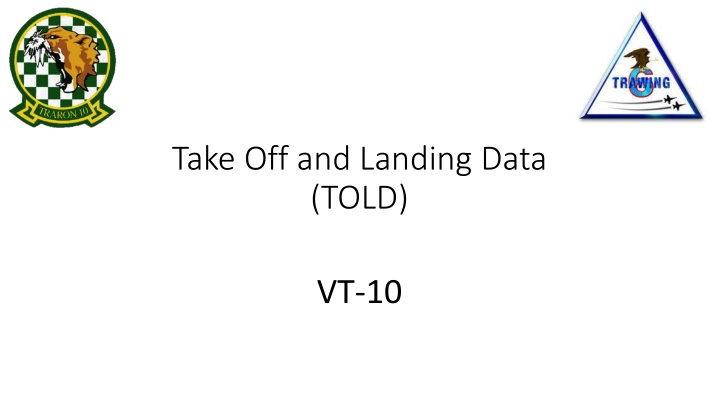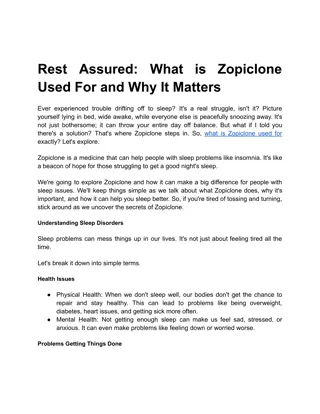
Aircraft TOLD Calculations for Safe Takeoff and Landing
Learn about Takeoff and Landing Data (TOLD) calculations essential for flight safety, including factors like aircraft weight, atmospheric conditions, runway status, and wind impact.
Download Presentation

Please find below an Image/Link to download the presentation.
The content on the website is provided AS IS for your information and personal use only. It may not be sold, licensed, or shared on other websites without obtaining consent from the author. If you encounter any issues during the download, it is possible that the publisher has removed the file from their server.
You are allowed to download the files provided on this website for personal or commercial use, subject to the condition that they are used lawfully. All files are the property of their respective owners.
The content on the website is provided AS IS for your information and personal use only. It may not be sold, licensed, or shared on other websites without obtaining consent from the author.
E N D
Presentation Transcript
Take Off and Landing Data (TOLD) VT-10
Purpose of calculating TOLD TOLD calculations are crucial for flight safety because they help pilots determine if an aircraft can safely takeoff and land given the prevailing conditions (weight, altitude, temperature, runway length, etc.). Performance Performance Charts: TOLD calculations rely on performance charts found in NATOPS. Charts: Factors Factors to Consider: to Consider: These calculations take into account various factors, including: 1. Aircraft Weight: : The heavier the aircraft, the longer the distances required for takeoff and landing. 2. Atmospheric Conditions: Altitude and temperature significantly impact aircraft performance. 3. Runway Conditions: Runway length, surface type (e.g., dry, wet, ice), and elevation all influence takeoff and landing distances. 4. Wind: Headwinds help with takeoff and landing, while tailwinds can increase distances.
TOLD Card TOLD card is found in the T-6A NATOPS (Page A9-8, Figure A9-2) Prior to brief it is the student s responsibility to ensure the TOLD card is accurate for the brief. The SDO will normally have the TOLD calculated for the environmental conditions for the day for Navy Sherman (KNPA) It is your responsibility to ensure the data is correct If the data does not support your planned route of flight, (ie. Destination other than KNPA, Field PA, runway conditions, etc) calculate TOLD data that will support your flight!!!!
Condition Data - Gross Weight Takeoff and landing gross weight for the aircraft can be found on the Form-F found in the ADB in Maintenance control You can assume at take off max gross weight (6500lbs) For landing gross weight subtract your expected amount of fuel burn from your takeoff weight As a rule of thumb, you will be approximately 500lbs per hour while flying If you are flying an event that is 2.0 you will burn approximately 1000lbs If you flying an event that is a scheduled 1.5 you will burn approximately 750lbs (round to 800lbs) Example (6500lbs take off weight 800lbs of fuel burn = 5700lbs landing weight)
Condition Data OAT / PA OAT OAT can be found on the DD175-1 in the remark section Utilize the MAX forecasted OAT to account for the worst possible conditions of the day Pressure Altitude PressureAltitude can be found on the DD175-1 in the remark section If your destination airfield is different from the departure airfield make sure to calculate landing data with the environmental conditions expected at the destination
Condition Data Wind Component Wind Component Wind is a very important consideration when calculating TOLD Headwinds will decrease takeoff and landing distances and tailwinds will increase takeoff and landing distances For pre-flight planning purposes assuming a wind component of zero is a conservative approach in most cases: However, if you know you will have to takeoff or land with a tail wind it is imperative you calculate TOLD with your expected tail wind component In most cases, airports will normally operate runways with a headwind component, but in certain cases aircrew may accept a tailwind (within NATOPS limits) due to instrument approach requirements, terrain avoidance, or other factors Gusts factors increase landing threshold and touchdown speeds by 50% of the gust factor up to a maximum speed of 10 knots. Example: (winds are 320 @ 10 gust 24) increase landing threshold and touchdown speeds by 6 knots. ((24-10) / 2)
Condition Data - RCR Runway Condition Reading (RCR) is a measure of the braking friction coefficient. RCR is given as a whole number. Values vary from 26 (the maximum braking friction coefficient), to 2 (the minimum braking friction coefficient). This value is used to define the braking characteristics for various runway surface conditions. International Civil Aviation Organization (ICAO) standards (good, medium, and poor). The following illustrates the relationship between RCR and ICAO reports:
Condition Data Runway Length Input the runway length of your destination and departure airfield If there are multiple runways assume the shortest (legal) runway
Takeoff Charts All takeoff figures can be found in NATOPS Appendix A Part 3 This section incudes calculating the following: 1. Takeoff Distance 2. Minimum Torque at 60KIAS 3. Rotation Speed / Obstacle speed
Takeoff Charts Takeoff Distance All takeoff figures can be found in NATOPS Appendix A Part 3 or in the PCL under the performance tab Assume a takeoff flap configuration of flaps T/O
Takeoff Charts Minimum Power at 60KIAS All takeoff figures can be found in NATOPS Appendix A Part 3 You will need to calculate expected IOAT corrected for OAT (True OAT=Indicated OAT-Temperature Correction) Prior to brief we know our OAT so we will need to add the temperature correction of 7 (21 =IOAT-7 ) 21+7=28
Takeoff Charts Rotation Speed All takeoff figures can be found in NATOPS Appendix A Part 3 Assume a takeoff flap configuration of flaps T/O Rotation speed obstacle speed can be found in the top right hand corner of the chart
Landing Charts All landing data figures can be found in NATOPS Appendix A Part 8 or in the PCL under performance tab This section incudes calculating the following for your departure and destination airfield: 1. Approach speed for each flap configuration (LDG/TO/UP) 2. Landing distance for each flap configuration (LDG/TO/UP)
Landing Charts Landing Distance Flaps LDG/TO/UP
Landing Charts Landing Distance Flaps LDG/TO/UP Enter the chart at the left hand side Follow the chart down and correct for the existing conditions Approach and Touchdown Speed Approach and touchdown speed can be found in the top right hand corner of the chart Make sure to subtract your fuel burn for the destination airfield and round to the nearest 500lbs ***We will go through a practice example next***
Class decides: 1. Do the problem on your own 2. Work the problem as a class
Example TOLD Problem Follow Along with your PCL Follow Along with your PCL Given Landing Data Gross Weight 5700lbs (FORM-F) OAT: 30 C (DD175-1) Field Pressure Altitude: 4000ft (DD175-1) Wind Component: 0 Knots RCR: Wet: 12 Runway Length: 5000ft (Field Diagram) Given Takeoff Data Gross Weight 6500lbs (FORM-F) OAT: 25 C (DD175-1) Field Pressure Altitude: 25ft (DD175-1) Wind Component: 0 Knots RCR: Dry - 25 Runway Length: 5000ft (Field Diagram)
Example TOLD Solution 6500 25 25 0 5700 30 Given Landing Data Gross Weight 5700lbs (FORM-F) OAT: 30 C (DD175-1) Field Pressure Altitude: 4000ft (DD175-1) Wind Component: 0 Knots (assume worst case scenario) RCR: Wet Runway Length: 5000ft (Field Diagram) Given Takeoff Data Gross Weight 6500lbs (FORM-F) OAT: 25 C (DD175-1) Field Pressure Altitude: 25ft (DD175-1) Wind Component: 0 Knots (assume worst case scenario) RCR: Dry - 25 Runway Length: 5000ft (Field Diagram) 4000 0 25 5000 12 5000 3000 100 88/107 102/91 2200 90/79 3200 107/97 2600 96/86 3600 104/94 3900 114/104 2800
Takeoff Data Given Takeoff Data Gross Weight 6500lbs (FORM-F) OAT: 25 C (DD175-1) Field Pressure Altitude: 25ft (DD175-1) Wind Component: 0 Knots RCR: Dry - 25 Runway Length: 5000ft (Field Diagram)
Takeoff Considerations We need to account for all takeoff data to determine our takeoff distances and power. It is imperative we calculate our landing data for the environmental conditions present at departure due to unforeseen circumstances such as emergencies which require a landing immediately after departure.
OAT: 25 C (DD175-1) 100 (OAT+Correction) IOAT = 25+7=32
Given Takeoff Data Gross Weight 6500lbs (FORM-F) OAT: 25 C (DD175-1) Field Pressure Altitude: 25ft (DD175-1) Wind Component: 0 Knots (assume worst case scenario) RCR: Dry - 25 Runway Length: 5000ft (Field Diagram) Takeoff Distance Explained 1. Enter at OAT for the day (25 C) 2. Track over to the Field PA (25FT- 3. Follow chart to Gross Weight (6500LBS) 4. Input runway gradient (0 in this case) 5. Wind Component (Assume 0 head wind) 6. Obstacle height (Assumed 0 if no known obstacles) 7. Track down to read take off distance (1600 ft) 1600 100 88 /107
6500 25 25 0 25 5000 Landing Distance Explained 1. Enter Chart at OAT (25 C) 2. Track over to PA (25ft) 3. Track down to Gross Weight (6500LBS) 4. Track down to runway gradient (0%) 5. Track down to wind component (0knots) 6. RCR (Dry) 7. Obstacle Height (0ft) 8. Landing Distance 2800ft 1600 100 88 /107 114/104 2800
6500 25 25 0 25 5000 Landing Distance Explained 1. Enter Chart at OAT (25 C) 2. Track over to PA (25ft) 3. Track down to Gross Weight (6500LBS) 4. Track down to runway gradient (0%) 5. Track down to wind component (0knots) 6. RCR (Dry) 7. Obstacle Height (0ft) 8. Landing Distance 2500ft 1600 100 88 /107 107/97 2500 114/104 2800
6500 25 25 0 25 5000 Landing Distance Explained 1. Enter Chart at OAT (25 C) 2. Track over to PA (25ft) 3. Track down to Gross Weight (6500LBS) 4. Track down to runway gradient (0%) 5. Track down to wind component (0knots) 6. RCR (Dry) 7. Obstacle Height (0ft) 8. Landing Distance 2200ft 1600 100 88 /107 102/91 2200 107/97 2500 114/104 2800
Landing (Destination) Data Given Landing Data Gross Weight 5700lbs (FORM-F) OAT: 30 C (DD175-1) Field Pressure Altitude: 4000ft (DD175-1) Wind Component: 0 Knots (assume worst case scenario) RCR: Wet -12 Runway Length: 5000ft (Field Diagram)
Landing Considerations Many different items can change between the departure and destination airfields that need to be taken into considerations. Examples of changes are as follows: 1. Aircraft weight due to fuel burn 2. OAT 3. Pressure altitude changes due to elevation gain at destination 4. Runway conditions (RCR) due to weather (precipitation) It is important to note, as this example shows, your landing data may not always be better than your departure data!!!
6500 25 25 0 25 5000 Landing Distance Explained 1. Enter Chart at OAT (30 C) 2. Track over to PA (4000ft) 3. Track down to Gross Weight (6700LBS) 4. Track down to runway gradient (0%) 5. Track down to wind component (0knots) 6. RCR (Wet) 7. Obstacle Height (0ft) 8. Landing Distance 3900ft 1600 100 88 /107 102/91 2200 107/97 2500 114/104 2800 104/94 3900
Landing Distance Explained 1. Enter Chart at OAT (30 C) 2. Track over to PA (4000ft) 3. Track down to Gross Weight (5700LBS) 4. Track down to runway gradient (0%) 5. Track down to wind component (0knots) 6. RCR (Wet) 7. Obstacle Height (0ft) 8. Landing Distance 3400ft 96/86 3400
Landing Distance Explained 1. Enter Chart at OAT (30 C) 2. Track over to PA (4000ft) 3. Track down to Gross Weight (5700LBS) 4. Track down to runway gradient (0%) 5. Track down to wind component (0knots) 6. RCR (Wet) 7. Obstacle Height (0ft) 8. Landing Distance 2900ft 90/79 2900 96/86 3400
Example TOLD Solution 6500 25 25 0 5700 30 Given Landing Data Gross Weight 5700lbs (FORM-F) OAT: 30 C (DD175-1) Field Pressure Altitude: 4000ft (DD175-1) Wind Component: 0 Knots (assume worst case scenario) RCR: Wet Runway Length: 5000ft (Field Diagram) Given Takeoff Data Gross Weight 6500lbs (FORM-F) OAT: 25 C (DD175-1) Field Pressure Altitude: 25ft (DD175-1) Wind Component: 0 Knots (assume worst case scenario) RCR: Dry - 25 Runway Length: 5000ft (Field Diagram) 4000 0 25 5000 12 5000 3000 100 88/107 102/91 2200 90/79 3200 107/97 2600 96/86 3400 104/94 3900 114/104 2800





















